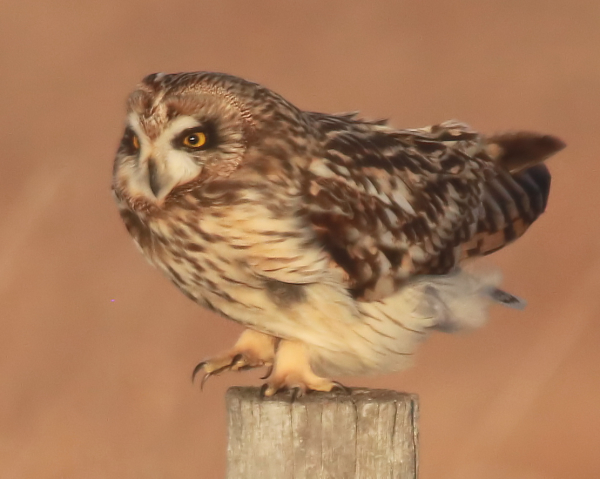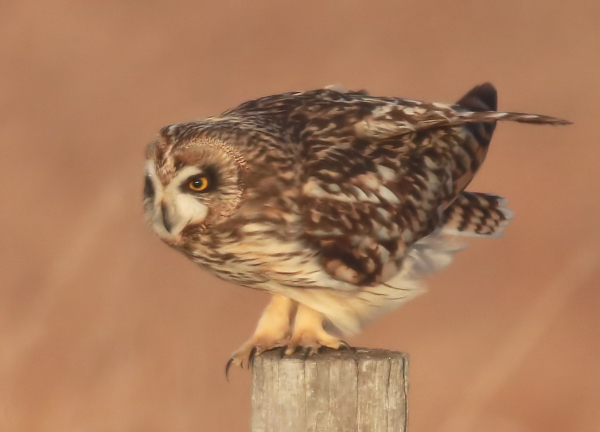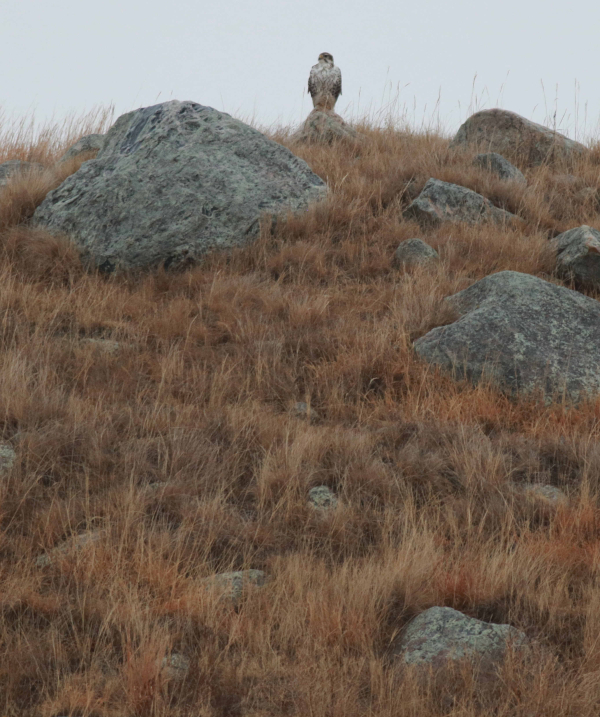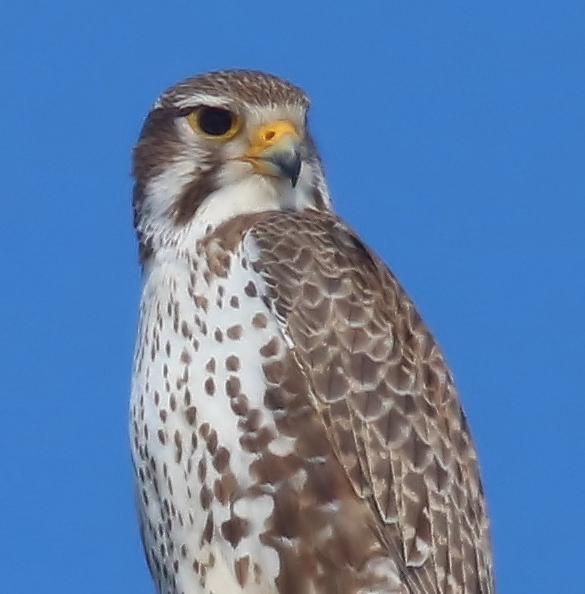
A strong gust of wind made the Short-eared Owl turn sideways to face into the wind. Note its raised foot as it turned.

The next photo frame caught the impact of the gusting wind as it caught the owl’s wings and tail, throwing it off-balance momentarily.

The big female Prairie Falcon was a real surprise on the boulder-rich hillside along the Missouri River breaks.

The majesty of a Prairie Falcon is more evident in this portrait photo, taken during a SoDak photo trip 3 years earlier.
|
As I started my afternoon drive to Bismarck, the sun slipped behind a cloud bank that would bring a January rain to the expansive northern plains before me. Likely not great birding weather, but better than Thursday’s coming windstorm. Would there be more owls? Indeed, even more than my 3 owl day the previous Saturday – but just one species this time, in the form of 4 Great Horned Owls! One on the open prairie, 3 south of Bismarck east of the wooded bottomlands of the Missouri River. But the real excitement was a sighting of a favorite raptor.
Between Beaver Bay and Bismarck there is an especially beautiful ridge of high prairie hills that attract a Golden Eagle, Bald Eagle, Swainson’s Hawk, or Red-tailed Hawk at times. This trip I spied a raptor perched on the crest of a secondary hill overlooking a broad valley. It was big, and I imagined it was either a Ferruginous Hawk or a Red-tail as I reached for my binoculars. Either species would be rare during winter; but hey, it was 50 degrees outside and raining – not your normal Dakota January afternoon. The sprinkles made my view less than optimum, but it was immediately clear this was no mere hawk – it was a big falcon.
Peregrine Falcon was my first inclination, but I knew it was unlikely, and quickly realized it was a fine Prairie Falcon, braving the rain, but seemingly grounded. The hillside was littered with big boulders left by a giant glacier millennia ago, but it took on another level of natural attraction with the Prairie Falcon perched on the apex. It was interesting to see the strong facial markings of this Prairie Falcon and the fact that it chose a small rock as its perch instead of one of the adjacent boulders. Finally, I thought I should take a couple documentary photos, just to see how they might turn out; and I was surprised to see how well look considering under poor photo conditions.
So that was a tally of 4 Great Horned Owls, a surprise Prairie Falcon, and 6 Ring-necked Pheasants – all solos, 5 cocks and a hen, along a 7-mile stretch of roadside a few miles before I entered the raptor hills segment of the drive. Obviously absent from the entire road trip were any passerines – no Horned Larks, Lapland Longspurs, Snow Buntings, or any other songbirds. That night the predicted Alberta clipper blew through and put birding on hold.
Post-Clipper Birding
The wind died down a bit from 50mph Thursday to 22mph Friday afternoon, and no new snow fell during the storm, so I decided to check my usual local north-south birding transect. No birds showed themselves along my drive 7 miles north, nor for 10 miles south. But finally, at mile 11 south, a Great Horned Owl was evident in a stand of big cottonwood trees that holds a Red-tailed Hawk nest. Was the owl checking out or claiming the nest during the hawks’ winter absence, or was it an incidental sighting on my part? It’s only about 5 weeks from the first eggs being laid by Great Horned Owls, and considering the mild winter, perhaps they may begin laying a week or so early.
As I reversed direction back toward my office, thinking about the owl nesting potential, I was surprised when a flock of 11 Sharp-tailed Grouse burst into flight next to my vehicle and flew directly across my windshield from left to right. I imagined them calling tuk-tuk-tuk as they gained speed and elevation on rapid wingbeats.
Short-ear Shots
Waiting for the sun, I worked through Saturday afternoon until time began running out on the daylight; then headed south, where I had the most luck this week and where a break in the clouds to the southwest promised photo light pronto. I was a few miles south when the sun broke through the 4-day cloud cover, illuminating the open landscape – now where were the birds? The promise of sunshine during the next hour propelled my decision to extend my drive toward the border between the Dakotas, but only 2 miles south of where I observed the Great Horned Owl the previous afternoon, I was happy to see a Short-eared Owl perched on a post next to the road, on the edge of an expansive rolling prairie tract.
At first it looked like a big-faced huddled gnome, and it nervously looked north, then south, then north again – seeming to avoiding looking in my direction, perhaps to keep from looking straight into the sun. The wind was blowing the owl’s plumage wildly and although it was facing into the wind, it was hunting in every direction, watching, although the wind may have been hampering its acute hearing. I eased a few feet forward, hoping to get some of the owl’s wing and tail in view as I tried to improve on my initial photos. That’s when a stronger prolonged gust of wind forced the owl to turn, and turn again, until it was actually broadside to me – perfect.
As it made its positioning change, the wind caught the owl’s wing and tail and with its head ducked, the owl’s momentarily enlarged size produced my favorite image of this quickly improving photo session. Now the full range of color of the Short-eared Owl was in view as the owl was visibly bothered by the up-scaled wind. I took a few more photos as it faced into the wind, as it looked in my direction again, and then it was off in a low-profile flight that took it into a low dip in the terrain.
I waited for it to return to view, but that didn’t happen. Apparently the owl opted to shelter from the intensified wind in the long grass below the hillcrest, but I reveled at the opportunity to spend a little time with this trusting Short-eared Owl along the deserted road. Hoooray! I covered several more bird-less miles and headed back to the office as the sun was setting. The western sky was colored pink by the time I spied the second bird of the outing – a Great Horned Owl hunting from its perch just 3 miles south of home. Winter owls have sure been dominating the avifauna beyond my feeders the past couple weeks, and I’m especially glad to have had the chance to photograph a special owl with the return of a little January sunshine.
More Owls
Waiting for the sun on Sunday, time was running out again, so I drove south to see if any owls were evident. I drove 17 miles south without seeing a bird, but upon my return, the Short-ear was perched near where I found it 24 hours earlier (13 miles south of my office). It didn’t remain inactive long; before I could stop, the long-winged owl took flight and actively hunted across a quarter-mile long area of tall prairie hills.
The owl’s flight was erratic, swirling one way then back, mostly low over the grasses, up and down but never very high. During the period I watched, the owl made at least 3 strikes, possibly 5. It was hard to tell a couple times whether the owl was on the ground resting, or if it caught a small rodent and was feeding. It was fun to watch the Short-eared Owl’s flights, but as the sun set I drove home, finding a Great Horned Owl 11 miles from home, and another just 2 miles south. Aah, another 3 owl outing!
Article and photos by Paul Konrad
Share your bird sightings and photos at editorstbw2@gmail.com